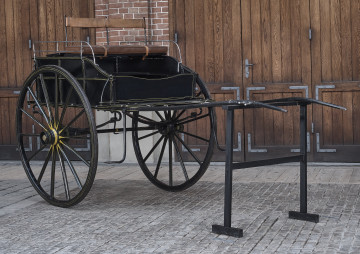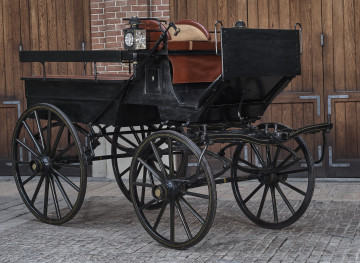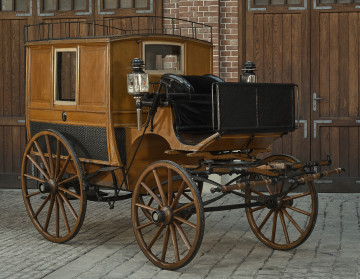
Charette
19th / 20th century
Castle Museum in Łańcut
Part of the collection: Vehicles and harnesses
A French cab is a four-wheel carriage for two passengers with a coachman's box, without doors and a body that is much smaller than in the case of a coupé. Instead of doors, at the front, in front of the two-person seat for the passengers, it has a wooden flap which, when lifted on hinges placed by the footstool, allowed for getting in and out of the carriage. Additionally, by the front edge of the roof, there is a suspended window comprising two separate window panes in the shape of a rectangle, also connected with hinges, and the passengers could get inside only after lifting (folding) it. The two window panes, tightly matching the upper edge of the flap, enclose the passengers like in a case ˗ as the wavy flap leaves limited space for the passengers’ feet. Getting out of the carriage was possible only with the assistance of a footman who had to put the flap aside with one hand and lift the window with the other. A footman dressed in a uniform resembling the driver's livery occupied a seat next to him on the box. This type of carriage originated from a two-passenger London Hansom cab, which was a vehicle for rental; its name derives from Brit Joseph Hansom, who patented it in 1834. However, the Hansom cab was drawn by one horse, and had two-winged low doors opening sideways, without a front window; furthermore, the driver sat on a high box placed behind the body. It is interesting to note that the French cab, which the Potocki spouses called “Chicago”, was the favourite carriage of the elderly Countess Maria Alfredowa Potocka (deceased in 1903), second Ordynat’s widow, possibly because it had a low, stable and wide footstep for getting in. Such cab was present in every residence where Countess Maria Alfredowa stayed at ˗ here, it is a black city cab. Aldona Cholewianka-Kruszyńska
Other names
French Cab
Author / creator
Dimensions
height: 192 cm, width: 163 cm
Object type
Vehicles and harnesses
Technique
installation
Material
glass, leather, metal, wood, cloth
Origin / acquisition method
decyzja administracyjna
Creation time / dating
Creation / finding place
Owner
Castle Museum in Łańcut
Identification number
Location / status

19th / 20th century
Castle Museum in Łańcut

19th / 20th century, 20th century, 19th (?) century
Castle Museum in Łańcut

19th (?) century
Castle Museum in Łańcut
DISCOVER this TOPIC
Museum of King Jan III's Palace at Wilanów
DISCOVER this PATH
Educational path